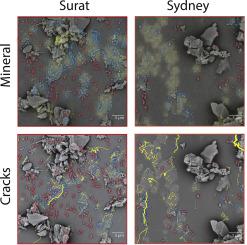当前位置:
X-MOL 学术
›
Int. J. Coal Geol.
›
论文详情
Our official English website, www.x-mol.net, welcomes your
feedback! (Note: you will need to create a separate account there.)
Adherent microbes in coal seam environments prefer mineral-rich and crack-associated microhabitats
International Journal of Coal Geology ( IF 5.6 ) Pub Date : 2021-02-01 , DOI: 10.1016/j.coal.2020.103652 Andrew G. McLeish , Silas H.W. Vick , Mihaela Grigore , Kaydy L. Pinetown , David J. Midgley , Ian T. Paulsen
International Journal of Coal Geology ( IF 5.6 ) Pub Date : 2021-02-01 , DOI: 10.1016/j.coal.2020.103652 Andrew G. McLeish , Silas H.W. Vick , Mihaela Grigore , Kaydy L. Pinetown , David J. Midgley , Ian T. Paulsen

|
Abstract Biogenic coal seam gas is a bridge fuel that aids in the global transition to renewable resources. Since microbial activities form a significant portion of contemporary gas reserves, research into this area has increased over the past decade. As the initial attachment of early colonisers is considered the rate-limiting step, investigation into biofilm formation has enhanced our understanding in generating gas reserves for energy security. Observations across multiple studies of Australian and Chinese coal have reported biofilm formation centred around cracks on the coal surface. Examination of scanning electron micrographs revealed lighter-coloured areas on the coal surface containing higher densities of adherent microbes. In this study, a replicated investigation into these phenomena was conducted. Scanning electron microscopy, energy-dispersive X-ray spectroscopy, and image analyses were used to calculate microbial densities. The light-coloured regions were identified as mineral-rich regions. It was calculated that microbial density was significantly denser on crack-associated and mineral-rich areas. This study has demonstrated the selective preference for microbial attachment to the surface of coal where crack-associated and mineral-rich areas are present. Further investigation to ascertain the mechanisms behind these phenomena would provide further insight to this type of behaviour and enhance our understanding of subsurface microbial catabolism.
更新日期:2021-02-01











































 京公网安备 11010802027423号
京公网安备 11010802027423号